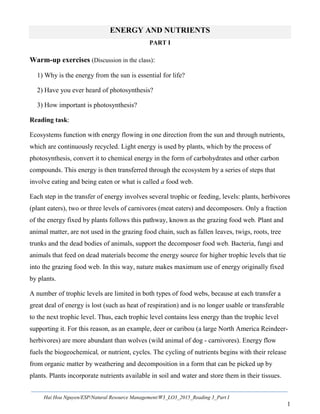
Photosynthesis and nutrient cycles
- 1. 1 Hai Hoa Nguyen/ESP/Natural Resource Management/W3_LO3_2015_Reading 3_Part I ENERGY AND NUTRIENTS PART I Warm-up exercises (Discussion in the class): 1) Why is the energy from the sun is essential for life? 2) Have you ever heard of photosynthesis? 3) How important is photosynthesis? Reading task: Ecosystems function with energy flowing in one direction from the sun and through nutrients, which are continuously recycled. Light energy is used by plants, which by the process of photosynthesis, convert it to chemical energy in the form of carbohydrates and other carbon compounds. This energy is then transferred through the ecosystem by a series of steps that involve eating and being eaten or what is called a food web. Each step in the transfer of energy involves several trophic or feeding, levels: plants, herbivores (plant eaters), two or three levels of carnivores (meat eaters) and decomposers. Only a fraction of the energy fixed by plants follows this pathway, known as the grazing food web. Plant and animal matter, are not used in the grazing food chain, such as fallen leaves, twigs, roots, tree trunks and the dead bodies of animals, support the decomposer food web. Bacteria, fungi and animals that feed on dead materials become the energy source for higher trophic levels that tie into the grazing food web. In this way, nature makes maximum use of energy originally fixed by plants. A number of trophic levels are limited in both types of food webs, because at each transfer a great deal of energy is lost (such as heat of respiration) and is no longer usable or transferable to the next trophic level. Thus, each trophic level contains less energy than the trophic level supporting it. For this reason, as an example, deer or caribou (a large North America Reindeer- herbivores) are more abundant than wolves (wild animal of dog - carnivores). Energy flow fuels the biogeochemical, or nutrient, cycles. The cycling of nutrients begins with their release from organic matter by weathering and decomposition in a form that can be picked up by plants. Plants incorporate nutrients available in soil and water and store them in their tissues.
- 2. 2 Hai Hoa Nguyen/ESP/Natural Resource Management/W3_LO3_2015_Reading 3_Part I The nutrients are transferred from one trophic level to another through the food web. Because most plants and animals go uneaten, nutrients contained in their tissues, after passing through the decomposer food web, are ultimately released by bacterial and fungal decomposition, a process that reduces complex organic compounds into simple inorganic compounds available for reuse by plants. READING CONPREHENSION Section 1: Questions Answer the questions about the reading: 1) How is light energy converted to chemical energy? 2) What does a food web consist of? 3) What are herbivores? 4) What are carnivores? 5) Why are herbivores more abundant than carnivores? 6) Why is the number of trophic levels limited? 7) What is a name of process as organic compounds are reduced into simple inorganic compounds available for reuse by plants? Section 2: True and false statements Write T if the sentence is true and F if it is false 1) The trophic level contains more energy than the trophic level supporting it: 2) Vegetations incorporate nutrients available in soil and water and store them in their tissues: 3) All of the energy fixed by plants is transferred through the ecosystem by the grazing food web: 4) Meat eaters are more abundant than plant eaters: 5) Bacterial and fungal decomposition is a process reducing complex organic compounds into simple inorganic compounds available for reuse by plants:
- 3. 3 Hai Hoa Nguyen/ESP/Natural Resource Management/W3_LO3_2015_Reading 3_Part I Section 3: Vocabulary Match each of the terms on the left with its relevant definitions on the right 1) Carnivore: A. any animal that eats only plants. 2) decomposition: B. a region characterized by similarities in its vegetation, living organisms and climate. 3) herbivore: C. the breakdown of dead plants and animals by organisms such as bacteria and fungi. 4) photosynthesis: D. a substance that is needed to keep a living thing alive and to help it to grow. 5) decomposer: E. any animal that eats meat. 6) omnivore: F. an animal which obtains its food from plants or other animals. 7) biome: G. the process in plants by which carbon dioxide is converted into organic compounds using the energy of light. 8) nutrient: H. an animal that eats all types of food, especially both plants and meat. 9) consumer: I. an organism that produces organic compounds from simple substances. 10) producer: J. any animal uses the bodies of dead animals and plants for its food.
